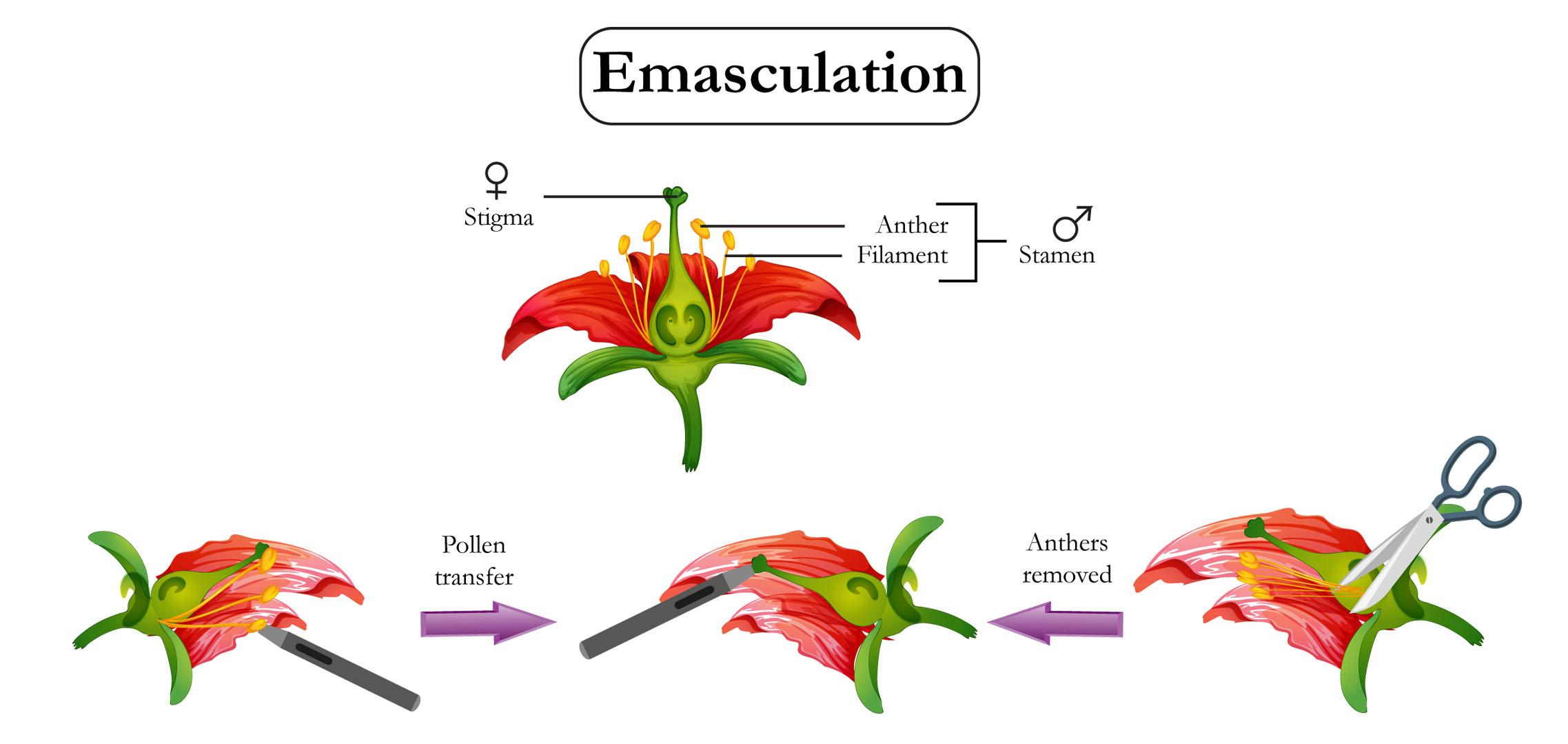
What is meant by emasculation? How is it useful in a plant breeding Programme?
Answer
487.8k+ views
5 likes
Hint: This is the process of removing anthers from bisexual flowers without affecting the female reproductive part (pistil), which is used in various plant hybridization techniques.
Complete Step by Step Answer:
Emasculation is the process of removing anthers from bisexual flowers without affecting the female reproductive part (pistil), which is employed in various plant hybridization techniques.
Emasculation is performed by plant breeders in bisexual flowers to get the specified form of a plant by crossing a specific plant with the specified pollen grain. For the removal of the anthers, the flowers are covered with a bag before they open. This makes sure that the flower is pollinated by pollen grains obtained from desirable varieties only. Later, the mature, viable, and stored pollen grains are dusted on the bagged stigma by breeders to permit artificial pollination to require place and acquire the specified plant variety.

Additional Information: Steps in Artificial Hybridization - Hybridization proceeds in two steps:
1) Emasculation
2) Bagging
Emasculation: We know hybridization is the method of selective breeding. Thus, anthers need to be removed from a bisexual flower before they release pollen grains. This step of removal of another using forceps is termed as emasculation. within the case of unisexual flowers, this step isn't necessary.
Bagging: Bagging is the protection of the emasculated flower from contamination by undesirable pollen grains. Here the flower is masked by a bag, still, the flower may attain receptivity. In unisexual flowers, bagging is completed before the flowers are open.
- Emasculation and bagging make sure that the female flower is totally protected from contamination.
- Once the flower attains stigma receptivity, the specified pollens are dusted on the stigma. This is often resealed for further developments.
- Hence, artificial hybridization ensures that the proper form of pollen has been transferred to the stigma of the flower. Additionally, the chance of fertilization is high. Through this approach, a spread of strains of crops is often developed and it improves the standard of the crop with desirable characters.
Note: Following are the major objectives of plant breeding:
- To increase the crop yield.
- To raise plants with desired characteristics.
- To develop a disease- resistant crop.
- To develop plants that may tolerate extreme environmental stress.
Complete Step by Step Answer:
Emasculation is the process of removing anthers from bisexual flowers without affecting the female reproductive part (pistil), which is employed in various plant hybridization techniques.
Emasculation is performed by plant breeders in bisexual flowers to get the specified form of a plant by crossing a specific plant with the specified pollen grain. For the removal of the anthers, the flowers are covered with a bag before they open. This makes sure that the flower is pollinated by pollen grains obtained from desirable varieties only. Later, the mature, viable, and stored pollen grains are dusted on the bagged stigma by breeders to permit artificial pollination to require place and acquire the specified plant variety.

Additional Information: Steps in Artificial Hybridization - Hybridization proceeds in two steps:
1) Emasculation
2) Bagging
Emasculation: We know hybridization is the method of selective breeding. Thus, anthers need to be removed from a bisexual flower before they release pollen grains. This step of removal of another using forceps is termed as emasculation. within the case of unisexual flowers, this step isn't necessary.
Bagging: Bagging is the protection of the emasculated flower from contamination by undesirable pollen grains. Here the flower is masked by a bag, still, the flower may attain receptivity. In unisexual flowers, bagging is completed before the flowers are open.
- Emasculation and bagging make sure that the female flower is totally protected from contamination.
- Once the flower attains stigma receptivity, the specified pollens are dusted on the stigma. This is often resealed for further developments.
- Hence, artificial hybridization ensures that the proper form of pollen has been transferred to the stigma of the flower. Additionally, the chance of fertilization is high. Through this approach, a spread of strains of crops is often developed and it improves the standard of the crop with desirable characters.
Note: Following are the major objectives of plant breeding:
- To increase the crop yield.
- To raise plants with desired characteristics.
- To develop a disease- resistant crop.
- To develop plants that may tolerate extreme environmental stress.
Watch videos on
What is meant by emasculation? How is it useful in a plant breeding Programme?

Sexual Reproduction in Flowering Plants Class12 NCERT EXERCISE1.15| Class 12 Chapter1| Kanika Sharma
Subscribe
 Share
Share likes
45 Views
1 year ago
Latest Vedantu courses for you
Grade 10 | CBSE | SCHOOL | English
Vedantu 10 CBSE Pro Course - (2025-26)
School Full course for CBSE students
₹37,300 per year
EMI starts from ₹3,108.34 per month
Recently Updated Pages
Master Class 9 General Knowledge: Engaging Questions & Answers for Success

Master Class 9 English: Engaging Questions & Answers for Success

Master Class 9 Science: Engaging Questions & Answers for Success

Master Class 9 Social Science: Engaging Questions & Answers for Success

Master Class 9 Maths: Engaging Questions & Answers for Success

Class 9 Question and Answer - Your Ultimate Solutions Guide

Trending doubts
Give 10 examples of unisexual and bisexual flowers

Draw a labelled sketch of the human eye class 12 physics CBSE

Differentiate between homogeneous and heterogeneous class 12 chemistry CBSE

Differentiate between insitu conservation and exsitu class 12 biology CBSE

What are the major means of transport Explain each class 12 social science CBSE

Draw a diagram of a flower and name the parts class 12 biology ICSE



 Watch Video
Watch Video
